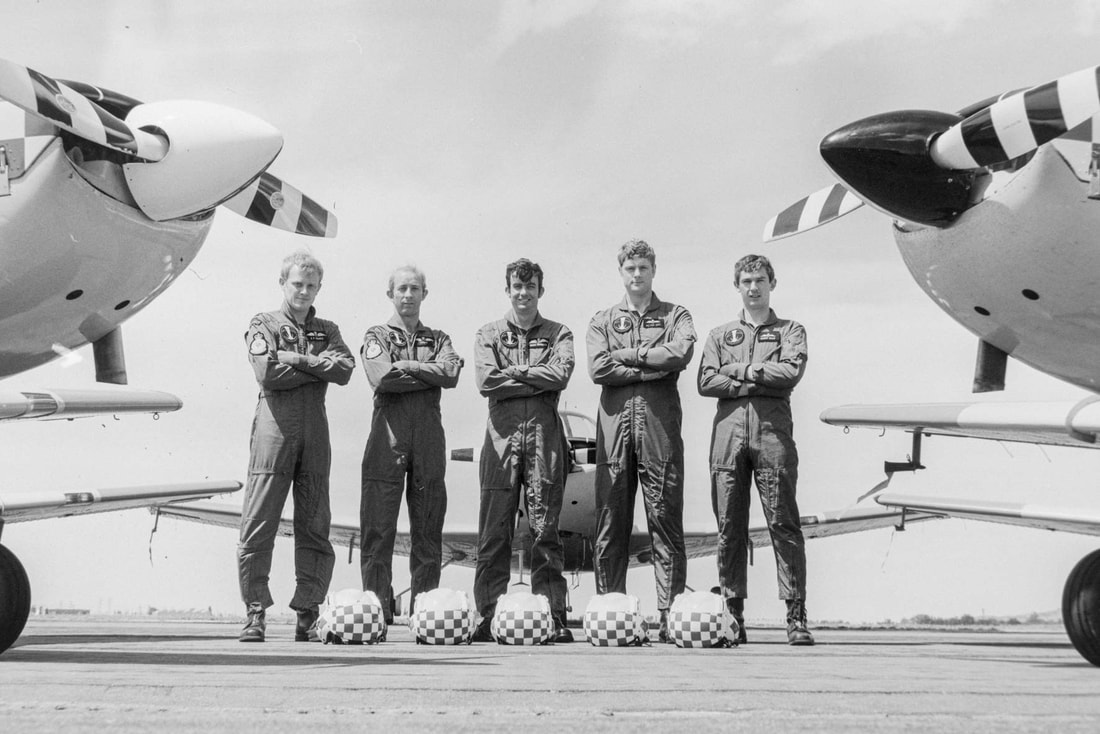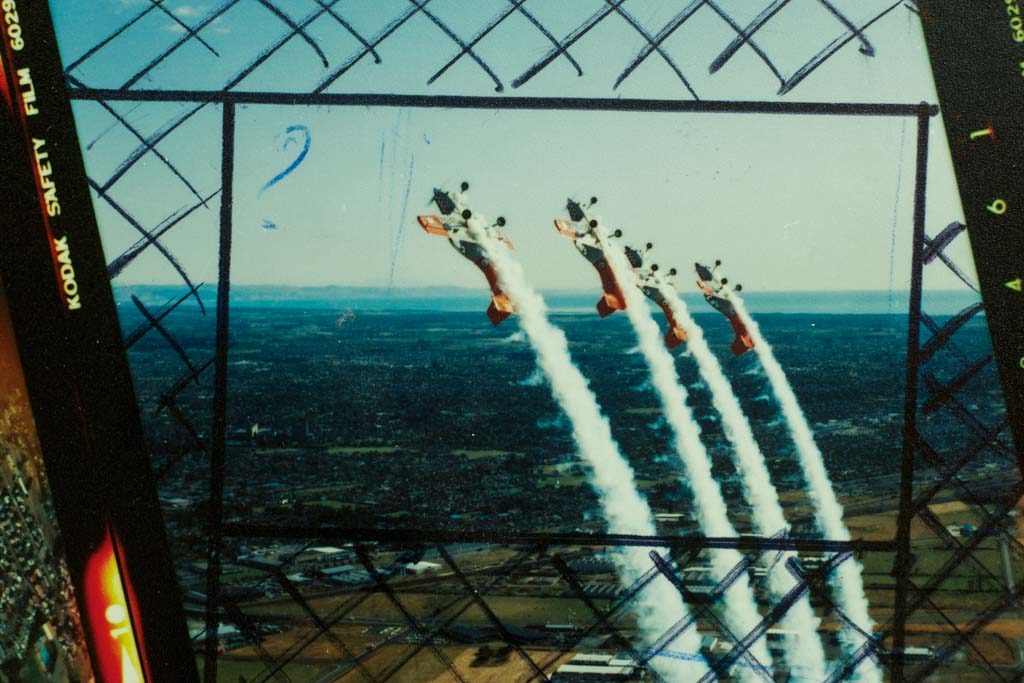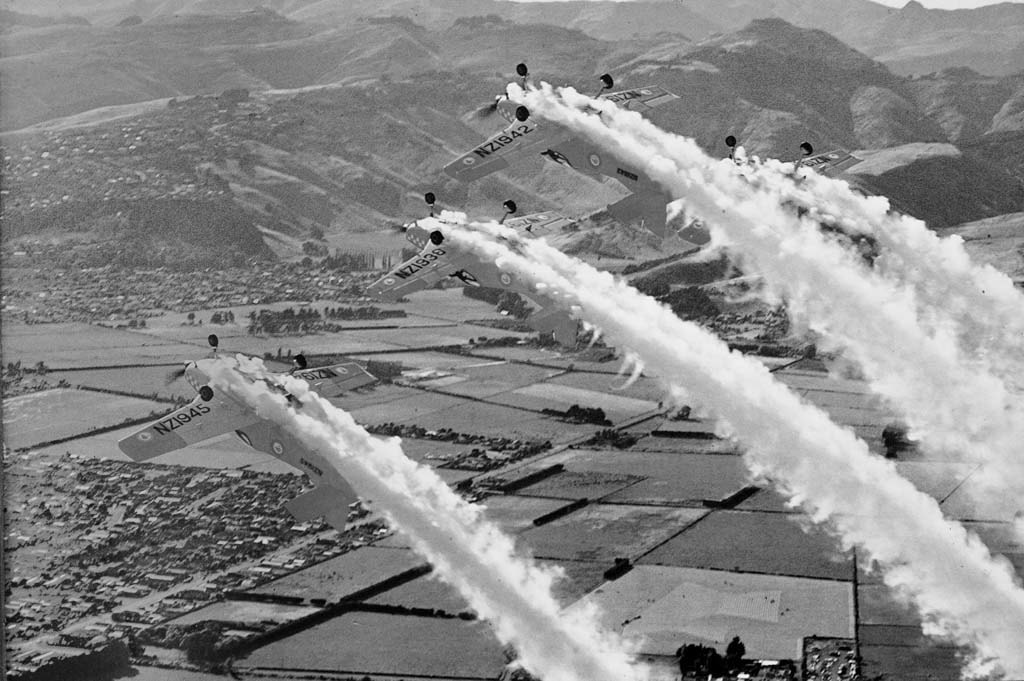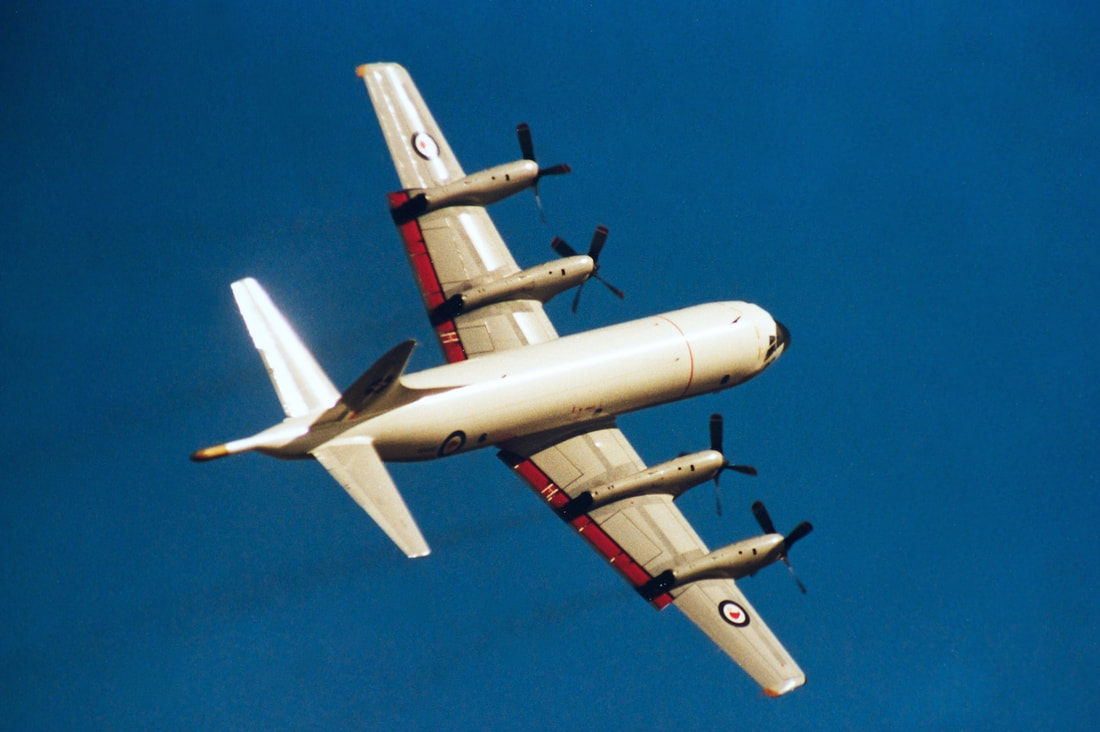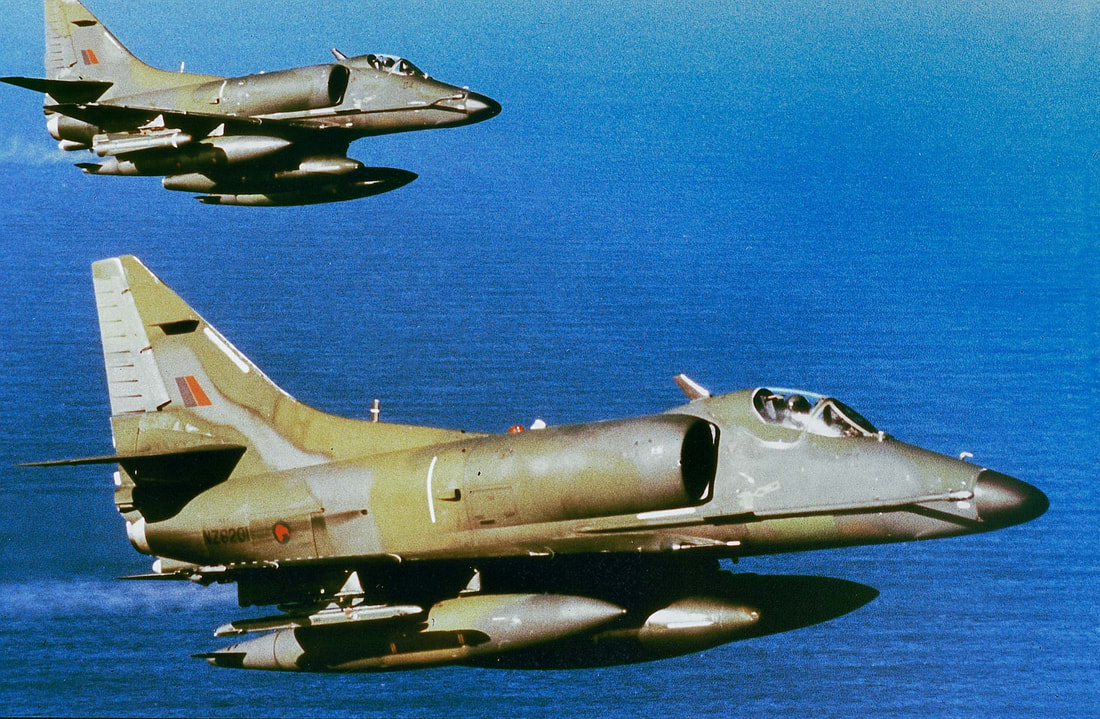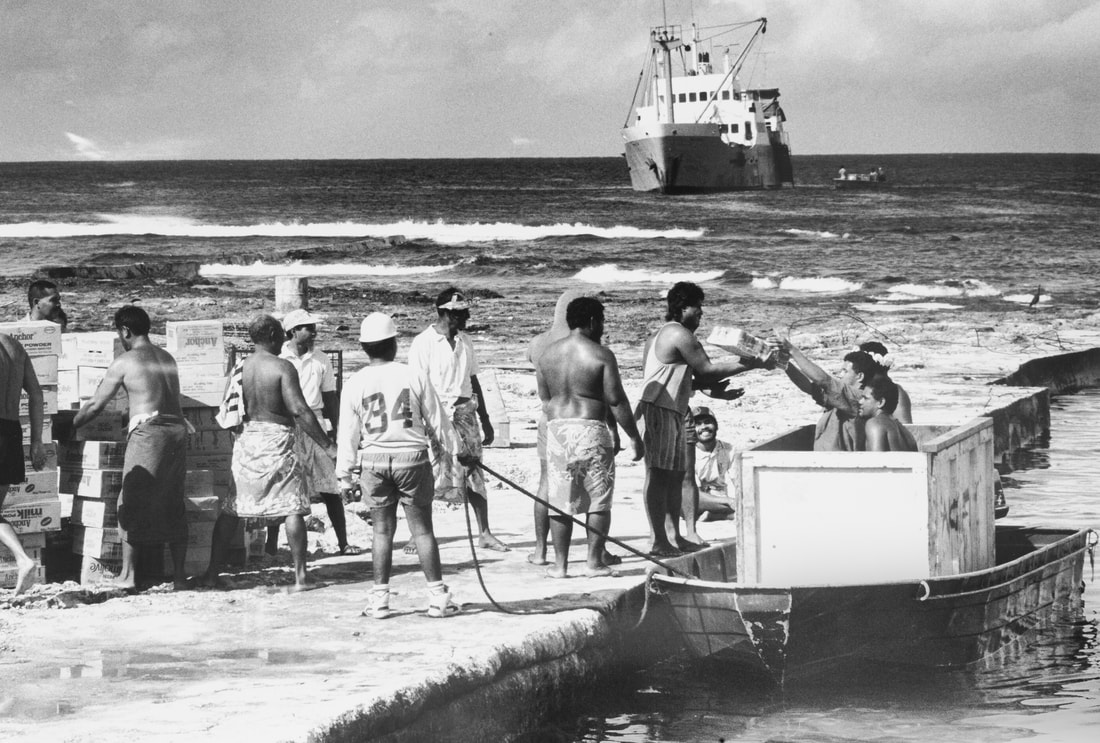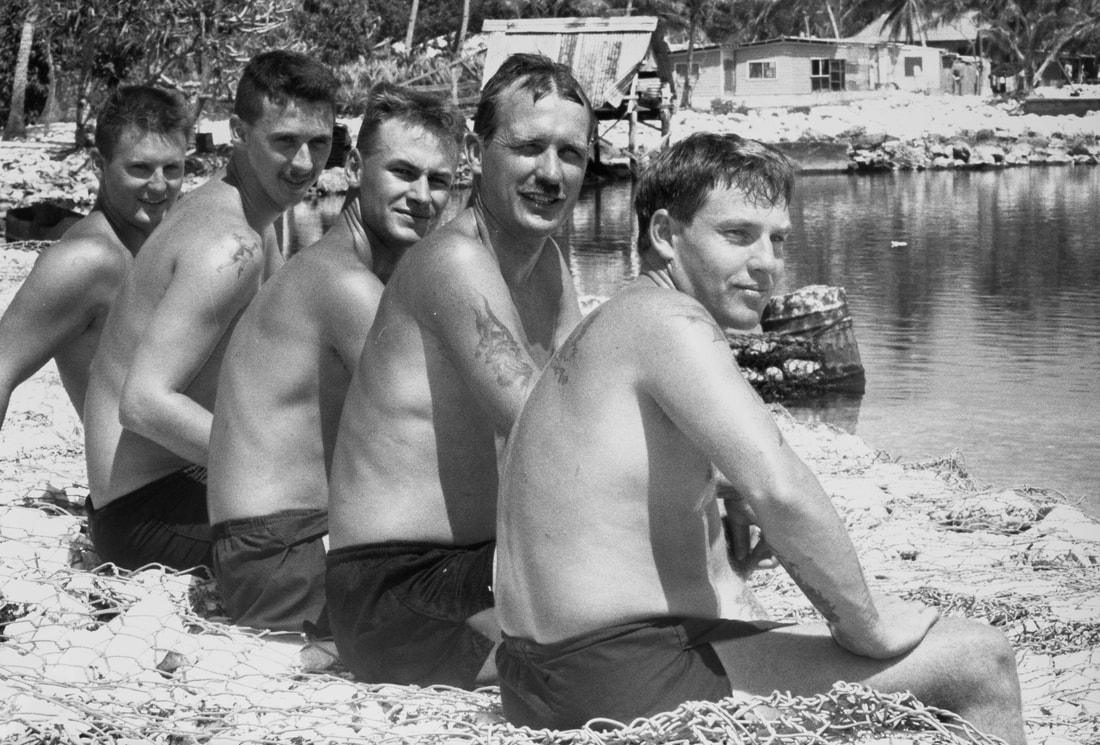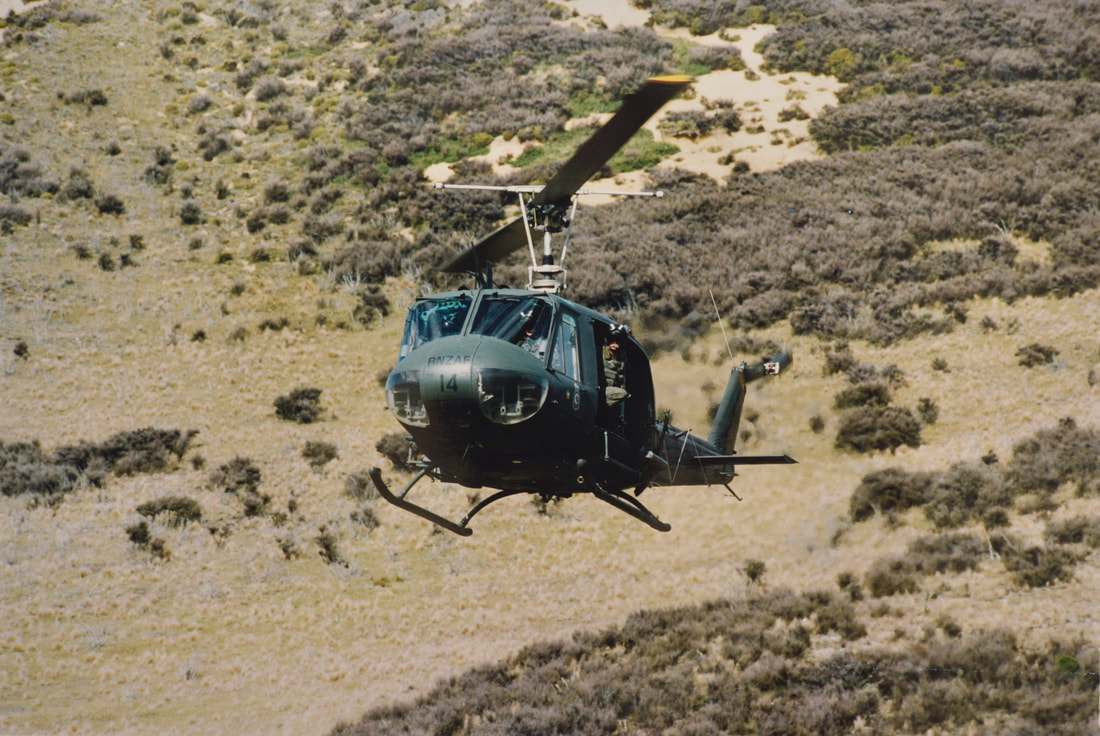Real adventures as an Air Force photographer in New Zealand
Aerobatics photography
The Red Checkers, in the early 1980's: Colin Pearce, Steve Bone, Bruce Ferguson, Malcolm Knox and Roger Read.
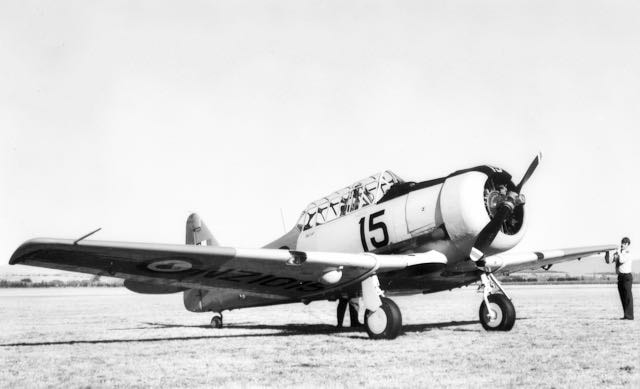
Initially I thought it was just a shot of the team (as above) on the ground but the excitement grew as it became clear that there was more to this task!
Aerobatics (from the aerobatic aircraft), for those of you that have never experienced the process, is a bit like a really, really smooth roller coaster ride, with gravitational forces so intense that your blood vacates the brain and you may pass out during positive G manoeuvres. Negative G is a rather unsettling feeling often resulting in burst blood vessels in the eyeballs. There was none of that on the flights I have done but I have seen pilots return to base with bloodshot eyes.
The first time I flew with the Red Checkers was in a Harvard (a WW2 pilot training aircraft which was one of the original Red Checkers aircraft).
As we started to taxi towards the runway, the pilot was going through his checklist and making sure I was all sorted.
We left the ground after a prolonged roar from the Harvard’s huge 9 cylinder radial engine with the five CT- 4 Air Trainers climbing into the air ahead of us. Wheels up. Now we just needed to fall-in behind the Air Force aerobatic team.
We did this repositioning and I slid the canopy back and locked it fully open, as planned.
Now we were ready for the fun to start!
The well-practiced routine began but as the G-force increased I struggled to keep my head up because of the weight of the helmet, the camera became "dead weight" on my lap and I puffed and panted due to physical stress, until I eventually passed out!
This occurred a number of times - but only at the bottom of a loop. The G force loosened a wee bolt in the winding mechanism of my Pentax 6x7 camera (10 shots per roll of film) which failed half way through the routine, so I said to the pilot that we might as well return to base. We finished the flight with the aerobatic team, landed and I went back to the Photo Section with my broken camera.
My pilot on the next occasion explained that the best way to combat blood loss to the brain was to prevent the blood from traveling directly to your lower body.
One way to do this is to imagine you are suffering from constipation and try to “force it out” by pushing from your solar plexus region - really hard! This eases the gravitational effect of blood flow away from your brain and traps some of that much needed blood in your upper body.
He said “You can grunt away as much as you like, no one is going to hear you up there!” So I put on the parachute (like a huge seat cushion), climbed into the backseat of the Harvard, strapped in and started to ease into my helmet and headset. One of the ground crew handed me my camera, a twin lens reflex Mamiya C330 this time (fewer moving parts that can fail).
Everything was going well as we climbed to the desired altitude with the aerobatic aircraft directly in front of us.
Then the Air Trainers all disappeared for my view (they had started their dive together) shortly after that all I could see was the patchwork quilt of the ground and the Harvard went really quiet (powered off) - we were diving towards the ground!
Suddenly five thick smoke trails stretched out, rocketing vertically across our boughs. A second later, under crushing G-forces (well, it seems that way when you are holding something with a bit of weight), the patchwork quilt was exchanged for sky, with a brief look at the horizon. Back to deafening full throttle for the “up hill” slog.
Aerobatics (from the aerobatic aircraft), for those of you that have never experienced the process, is a bit like a really, really smooth roller coaster ride, with gravitational forces so intense that your blood vacates the brain and you may pass out during positive G manoeuvres. Negative G is a rather unsettling feeling often resulting in burst blood vessels in the eyeballs. There was none of that on the flights I have done but I have seen pilots return to base with bloodshot eyes.
The first time I flew with the Red Checkers was in a Harvard (a WW2 pilot training aircraft which was one of the original Red Checkers aircraft).
As we started to taxi towards the runway, the pilot was going through his checklist and making sure I was all sorted.
We left the ground after a prolonged roar from the Harvard’s huge 9 cylinder radial engine with the five CT- 4 Air Trainers climbing into the air ahead of us. Wheels up. Now we just needed to fall-in behind the Air Force aerobatic team.
We did this repositioning and I slid the canopy back and locked it fully open, as planned.
Now we were ready for the fun to start!
The well-practiced routine began but as the G-force increased I struggled to keep my head up because of the weight of the helmet, the camera became "dead weight" on my lap and I puffed and panted due to physical stress, until I eventually passed out!
This occurred a number of times - but only at the bottom of a loop. The G force loosened a wee bolt in the winding mechanism of my Pentax 6x7 camera (10 shots per roll of film) which failed half way through the routine, so I said to the pilot that we might as well return to base. We finished the flight with the aerobatic team, landed and I went back to the Photo Section with my broken camera.
My pilot on the next occasion explained that the best way to combat blood loss to the brain was to prevent the blood from traveling directly to your lower body.
One way to do this is to imagine you are suffering from constipation and try to “force it out” by pushing from your solar plexus region - really hard! This eases the gravitational effect of blood flow away from your brain and traps some of that much needed blood in your upper body.
He said “You can grunt away as much as you like, no one is going to hear you up there!” So I put on the parachute (like a huge seat cushion), climbed into the backseat of the Harvard, strapped in and started to ease into my helmet and headset. One of the ground crew handed me my camera, a twin lens reflex Mamiya C330 this time (fewer moving parts that can fail).
Everything was going well as we climbed to the desired altitude with the aerobatic aircraft directly in front of us.
Then the Air Trainers all disappeared for my view (they had started their dive together) shortly after that all I could see was the patchwork quilt of the ground and the Harvard went really quiet (powered off) - we were diving towards the ground!
Suddenly five thick smoke trails stretched out, rocketing vertically across our boughs. A second later, under crushing G-forces (well, it seems that way when you are holding something with a bit of weight), the patchwork quilt was exchanged for sky, with a brief look at the horizon. Back to deafening full throttle for the “up hill” slog.
A "proof" of one of the 6x6cm sample images.
While going through the bottom of the loop "pulling up", I did what the pilot advised and grunted my way through the gravitational force that pushed me deep into my seat.
My helmet felt so heavy that I struggled to keep my head up. My arms were like lead, but I took a breath and kept grunting, until the forces eased and we began to climb again - vertically.
We were now pointing straight up with only sky to be seen.
The pilot’s voice came over the intercom “Let’s switch off your intercom next time, Colin” - I turned a very red colour (even though no one could see me).
The pilot had been a party to all of my grunting because I had missed turning the intercom switch OFF!
I could hear a horn blasting periodically, later discovering that this was the audible warning to the pilot that the wheels were up and power was minimal - so that you didn’t land with your wheels up (remember this is a WW2 aircraft).
I asked the pilot to move the aircraft off to one side of the aerobatic team, so that I could get a better shot of the display team “Roger that”, as he realigned us, “how’s this?”. “Great” I said as we approached the top of the loop.
Click - wind, click - wind “Excellent!”
Now comes the scary bit (for me anyway). The best position for doing shots of the team was going to be from their front three quarters area, so that we were slightly in front of them - off to one side.
This required some major twisting in the seat, so with this in mind, I had loosened my shoulder harnesses so that I could shoot back towards the five aircraft - big mistake. As we turned upside down and the positive G's receded I "fell" into the shoulder straps of the parachute, I dug my heels into the space below the seat pan as the slack in my harness was taken up. Basically I felt that I was falling out of the aircraft for a second, until I could feel the shoulder straps cut into my shoulders again - remember my canopy was open, nothing between me and the ground as we hung upside down!
Settling for shots from the side rear view was a safer approach, so I squeezed off a shot or two of the subjects, after all that is why I was there. My job was to photograph the aerobatic team going through their paces over the historic Wigram airfield for an Air Force publicity poster.
We went through this entire routine a couple of times so there was a lot less anxiety after that.
There were 12 shots on a roll of 120 when using a square format camera like the Mamiya C330. I did not need to reload while we were airborne, which was a great relief to me because when I take my eyes off the horizon to do something like putting in a new roll of film the G forces can make me feel really, really airsick.
Once back on the ground and I could get my "jelly like" legs to operate normally again - it was time to get the colour film processed for producing the poster - Job done!
Here is a video from another time: https://youtu.be/mcBKA3zadro
The finished product was in colour, but I was unable to get a copy of the full version - here it is in B+W anyway.
Old Defence images
Air to air shoot: P3 Orion to A4 Skyhawks
I was asked to jump aboard an RNZAF, P3 Orion ( a four engine turboprop maritime surveillance aircraft) to take photos of some A4 Skyhawks that had gathered for a maritime exercise off the coast of New Zealand’s Bay of Plenty.
Seemed simple enough, until I discovered that the Skyhawks would be restricted to flying within a big triangle of air space. This meant lots of direction changes and as a result lots of lighting changes.
For me to get ready to shoot I needed to attach a harness around my waist, go to the rear left door of the Orion, secure my harness to a “D” bracket on the floor, notify the pilot so they could throttle back to a safe speed, then open the door, pin it back so that I could stand in the doorway with nothing between me and the formation of wee jets that were coming up behind us.
It was freezing (as usual) and the roar of wind and engine noise made it virtually impossible to hear anyone speaking to me on the headset, so I resorted to hand signals for transferring the directions to the Orion pilot via the crewman who was just behind me.
The Orion pilot dropped the left wing a bit so that it was a clean shot without the wingtip or jet efflux from the hot gas exhausts.
There was a speed disparity also, so after a chat with the pilots of the P3 Orion, we came up with a plan.
It would take a while to get four Skyhawks and one Orion in the right bit of sky at the right time, so all of the pilots (Skyhawks and Orion) worked fast to get things happening.
The wee jets arrived on the scene, just as we had to break off again for another turn. Remember we were part of a maritime military exercise involving a number of countries, so we need to fit in with these limitations as part of being permitted to do these shots.
So the countdown began as we completed each bank to change direction. Often we would just about get into position then we would need to break-off to make another turn (very frustrating and stressful).
We had a few attempts at this and eventually we managed to the formation of Skyhawks as well as the Orion in the same bit of sky at the same time to get some shots within the very short timeframe, allocated.
At one point, once we were all set to shoot, the Skyhawks were going as slowly as they could without their wings opening up and we were going as fast as we could in the Orion with the door open but the wee jets were still advancing past the ideal position off our port wing. So the pilot said “Hang on” and he pushed us into a shallow dive to speed us up a bit. It worked - a wee bit frightening - but it worked - we got our shots - thanked all those involved - closed the door and went home!
Processed back at the base - Job done!
Old Defence images

Small jet shoot
An RNZAF P3 Orion had just won the Fincastle Trophy for Anti Submarine Warfare skills and was returning to NZ air space. The competition had been hosted by the Royal Air Force, in the UK.
Planned for about the same time was a training sortie for three Strikemaster jets (the BAC 167 Strikemaster is a British jet-powered training and light attack, two seater- side by side aircraft) in the northern skies of New Zealand.
The operations team had decided to combine the training sortie of three Strikemasters with an air to air photoshoot of the return to NZ of the victorious P3 Orion.
So late that afternoon I was asked to grab a camera (Mamiya RB67) and meet with the pilot of a Strikemaster jet for kitting out with a G-suit. This was sort of like a tightly fitting girdle for the lower part of your body which is plugged into the aircraft and was designed to inflate and deflate to counteract the result of G forces starving the brain of blood. A "May West" lifejacket, helmet with comms. etc, then straight out to the aircraft.
It was all a bit of a rush, but as we taxied I was given a safety briefing by the pilot that included how to eject, if required. The pilot would decide if there was an emergency and when to exit the aircraft.
The Strikemaster has a Martin Baker ejection seat that has two initiation points, the Face Blind (above your head) incase you are in a negative G situation and cannot get your hands down to reach the other trigger, the Seat Pan Handle between your legs (if you need to leave in a hurry). For safety reasons, if ejection is required I was to dump the camera as it could hinder successful operation of the ejection process.
With all of that out of the way, we left the ground and headed north. Apparently this was an “escape and evasion” type of exercise. As we reached the northern east coast we descended to about 250 feet from the water and we were moving rather quickly by this stage (Maximum speed of the Strikemaster was about 800 km/hour, although I do not think we were near that speed). When the other three "Blunties" were spotted it was "all-on" dogfighting. At one stage we were hiding behind a hill!
As you can imagine, in a speedy wee jet this was hard work and the G suit got a real workout and I was not feeling too bright.
As we sped around the sky doing the modern day "Biggles" thing, time was passing rather rapidly and the light was disappearing. I got a few formation shots of the "Blunties" but that was about all before we returned to base.
I eventually photographed the RNZAF P3 Orion winning team - but on on the ground!
Job done!
Tokelau Islands shoot
For this shoot, I flew to Samoa then joined an old boat, which used to be the ferry that travelled between NZ’s Bluff and Stewart Island, when I was a kid!
The vessel,that used to be called the Wairua, was now owned by a Fijian business and was in need of some maintenance but it was an important connection service between Samoa and the Tokelau group of islands.
In 1990 the Tokelau Islands experienced a devastating hurricane which stripped the atolls of coconut trees, crops and rearranged the protective sea walls. The NZ Army engineers were tasked with the job of rebuilding these sea walls. Diggers and other heavy equipment was used to fill big netting baskets with rock and coral. These were then positioned in the best locations to protect the islands from sea erosion.
There was only about a metre or so between the sea level and the highest part of the land, so the work these NZ Army engineers were carrying out were vital to the continued existence of the local people. The Tokelau group is well known, world wide, for it’s swimming pigs.
The coral atolls of Nukunonu, Atafu and Fakaofo, with a combined land area of 10 km2, make up the Tokelau group, which was called the Union Islands until 1976. The Tokelau group is a dependant territory of NZ, which is the reason we were all there.
I travelled between the three atolls to photograph the engineers and the work they were doing. There was also a bit of video shot there.
It had been very hot and dry while I was there so one day I went for a swim in the inner atoll at Nukunonu. The atoll was dotted with Sea Cucumbers (From Wkipedia: Sea cucumbers are echinoderms from the class Holothuroidea. They are marine animals with a leathery skin and an elongated body containing a single, branched gonad. Sea cucumbers are found on the sea floor worldwide) it was also a bit polluted, which I was not aware of when I submerged in this lagoon.
This wee swim started an ear infection (the worst I’d ever experienced, couldn’t open one eye and could not open my mouth properly!) which did not present itself until I was on my way home again.
We left the Tokelaus on the same vessel that delivered us there a week earlier. On this boat trip back to Samoa we stopped off at an island, where the local people prepared fruit for us to eat. I was offered a piece of Pawpaw and I was about to take a bite when I noticed a bit of skin was still attached to the freshly peeled quarter. I paused but the others said I should just eat it as it was, to be polite. It was very bitter but it was a very small piece of unpeeled fruit - so how bad could it be?
We headed back to the ship for the final leg of the journey back to civilisation. Soon after leaving the island I started to feel a bit “displaced” or light headed. So I went below for a “lie down”. Just before sunset on this beautifully calm, tropical evening I burst out of my bunk and launched myself up the stairs and just made it to the deck rail before discharging a powerful projectile vomit toward the sea. Boy you should have seen people move aside as this happened!
I felt so good after getting rid of that Pawpaw!
From this point we had a fairly straight forward voyage back to Samoa and flying home with the Air Force.
Process, get the detail matched up with the appropriate photo, then that was sent off to one of the forty-five newspapers around NZ.
Job done!
When I got back home to Wellington I started feeling really bad and I had to get my neighbours to take me to the nearest medical centre. My right eye had closed and refused to open as the result of a huge ear infection that I had picked up from that swim in the lagoon at Nukunonu. After a few days all was good again!
_____________________________________________________________________________
Great Barrier Island, NZ
Air to Ground (steep oblique) Aerial photography
I was tasked to do an air to ground photographic sortie of Great Barrier Island for a native tree survey of the northern part of the island, but the P3 Orion aircraft we were to use was unavailable at the time.
So, suddenly an Iroquois helicopter became our new photo survey platform (aircraft for the sortie)!
Together with my boss, we worked out a way to do this. It involved me (the photographer) lying on my stomach with a "monkey harness" around my waist, secured with a long strap to an anchor point in the middle of the Huey floor.
Then I needed to crawl forward out past the right hand skid (about another foot), so that I could point the camera (near) vertically to photograph the ground, while missing the skid.
Instead of the TTL prism viewfinder, I had added a direct vision viewfinder to the ‘Blad (which was more like a rifle sight than a viewfinder) just to keep the field of view or target in the right place.
The weather was not the best (high overcast, increasing cloud) but we left Hobsonville airfield in the afternoon and the Huey headed for the Island anyway.
I prepared my Hasselblad camera en route, checked the 120 magazines of colour negative film (12 shots per film) and the camera with a "U" grip handle (with shutter release) that was positioned by an overtightened tripod screw in the base, pulled out the dark slide, stowed it in my flying overalls and zipped up my ankle pockets so I wouldn't lose any bits in the aircraft.
With my harness on and secured to the floor, I felt okay and ready to take some photos.
I do not think we reached 10,000 ft, but It was pretty high for our aerial mapping survey in a helicopter. When we opened the door over Great Barrier Island it was cold, bloody cold!
A forward speed of around 60-70 knots (I think) introduced a significant chill factor. The heaters were on full-blast to keep a bit of warmth for the crew inside the Iroquois.
I checked my camera again, then lay on my stomach on the floor (as we had practiced on the ground).
Everything was all new to me from this point, so this is where it started to get interesting.
Crawling out into the slipstream at this speed and altitude sucked the air out of my lungs and I struggled to breath for a short while, all new and a bit scary.
The wind speed was really intense, magnitudes more than I had ever experienced before. My eyelids fluttered rapidly and uncontrollably, the fluid streamed from my eyes so that I could barely see through the camera sight, all new and a bit scary.
Then I realised it wasn't just my eyes that were streaming! My camera was covered in slippery mucus that was being ripped from my nose - and I could do nothing about it as I was using both hands to hold the camera, all new and a bit scary.
The helicopter crewman sat on my lower legs so I would not over balance and topple out the door. (This sense of security was rather important at this point, as you could imagine), all new and a bit scary.
Now, I do not know if any one has ever tried to take a hand held "vertical" photo before (even on the ground), but in a controlled situation it is really difficult to understand what is truly perpendicular.
But to do it at 10,000 ft over a green bush covered island while your face is leaking, well this is a new level of difficult, all new and a bit scary!
Looking down in an uncontrolled situation, all you can see is greenery or patchwork quilted camouflage and the "vertical" you end up with could be between 70 and 110 degrees of your forward traveling line. You cannot determine a true vertical because you have no reference points, like the horizon, to keep you on track.
Losing sight of the horizon while being buffeted about like a rag doll makes me fell quite airsick, normally. In this case there was so much going on that I did not feel like throwing up at all (it probably would not have been noticed if I had anyway, with all of the mucus and other stuff that was being sucked out of my face by the slipstream vacuum), all new and a bit scary.
If you gently pinch the outside of your right cheek and wobble it forward and back with intense frequency - that is what my mouth was doing (also uncontrollably) in this slipstream, with the resultant saliva depositing along the tail section of the chopper.
I just could not keep my mouth closed, all new and a bit scary.
Everything that has happened so far has occurred in the first few seconds of poking my upper body out into the slipstream but I had a job to do. Yep - I needed to take some photos!
The pilot's job was to fly in a straight line on a given course at a given altitude at a given constant speed and there would be a series of these "runs" that were all flown in the same direction (all worked out in advance). The idea was to end up with a forward overlap of each shot of 60% for stereoscopic viewing/mapping purposes, so you would get to the end of one run then you would zip back to the start point and begin the next run paralell to the last one, with a 30% lateral overlap of the previous.
Once I was in position for the first run I tried to get the camera assembly as vertical as possible. My boss would tap me on the back each time I was to push the shutter release button, at pre arranged intervals. This was all working well until we came to half way through the third run.
I could not suck in enough air to breathe and I let go of the left hand side of my camera’s U bracket, all new and a bit scary!
My body suddenly had more wind resistance and I was pulled, twisting toward the back of the aircraft a wee bit, all new and bloody scary!
This was the point when I started to think about something other than what I was supposed to be doing. Yep, I was on my way out!
At this point the helicopter crewman, who was sitting on my legs, felt me "going" so he grabbed me, pulled me back into the Huey, said "This is too dangerous - No more!", at which point he slid the door closed and locked it.
Once back inside the warm cabin I realised that my teeth were frozen to the inside of my left cheek (like when you put your hand on the inside wall of a deep freeze), they thawed fairly quickly but the uncontrolled buffeting action in the slipstream had stripped some layers of skin from my inside cheek.
The pilot then decided it was not safe to continue so we returned to the Air Force base.
In the time following this episode, I developed some bruising on the left hand side of my face (the windward side) also as a result of the constant buffeting.
At this point in my narrative I would normally say "Job done!" but in this case it was only half done and no replacement sortie was planned. The film was processed and it was decided that there was enough photographic coverage to complete the task.
Back at base, the ground crew would have had to face the job of washing down the helicopter after the shoot, but it would have been made worse with so much of my mucus on the rear right tail boom section :-(
This photography was the initial part of planning to establish a two week camp on the island to survey the native plant life, with a team of people to measure native tree sizes and variety later in the year, in support of the New Zealand Conservation Department, which I also provided photographic coverage for on the ground.
For many years following this "event" I had nightmares about free falling from a helicopter - at a significant altitude!
This all happened a long time ago and there is no way this sort of activity would be carried-out in today’s world - WHAT AN EXPERIENCE!
Then I needed to crawl forward out past the right hand skid (about another foot), so that I could point the camera (near) vertically to photograph the ground, while missing the skid.
Instead of the TTL prism viewfinder, I had added a direct vision viewfinder to the ‘Blad (which was more like a rifle sight than a viewfinder) just to keep the field of view or target in the right place.
The weather was not the best (high overcast, increasing cloud) but we left Hobsonville airfield in the afternoon and the Huey headed for the Island anyway.
I prepared my Hasselblad camera en route, checked the 120 magazines of colour negative film (12 shots per film) and the camera with a "U" grip handle (with shutter release) that was positioned by an overtightened tripod screw in the base, pulled out the dark slide, stowed it in my flying overalls and zipped up my ankle pockets so I wouldn't lose any bits in the aircraft.
With my harness on and secured to the floor, I felt okay and ready to take some photos.
I do not think we reached 10,000 ft, but It was pretty high for our aerial mapping survey in a helicopter. When we opened the door over Great Barrier Island it was cold, bloody cold!
A forward speed of around 60-70 knots (I think) introduced a significant chill factor. The heaters were on full-blast to keep a bit of warmth for the crew inside the Iroquois.
I checked my camera again, then lay on my stomach on the floor (as we had practiced on the ground).
Everything was all new to me from this point, so this is where it started to get interesting.
Crawling out into the slipstream at this speed and altitude sucked the air out of my lungs and I struggled to breath for a short while, all new and a bit scary.
The wind speed was really intense, magnitudes more than I had ever experienced before. My eyelids fluttered rapidly and uncontrollably, the fluid streamed from my eyes so that I could barely see through the camera sight, all new and a bit scary.
Then I realised it wasn't just my eyes that were streaming! My camera was covered in slippery mucus that was being ripped from my nose - and I could do nothing about it as I was using both hands to hold the camera, all new and a bit scary.
The helicopter crewman sat on my lower legs so I would not over balance and topple out the door. (This sense of security was rather important at this point, as you could imagine), all new and a bit scary.
Now, I do not know if any one has ever tried to take a hand held "vertical" photo before (even on the ground), but in a controlled situation it is really difficult to understand what is truly perpendicular.
But to do it at 10,000 ft over a green bush covered island while your face is leaking, well this is a new level of difficult, all new and a bit scary!
Looking down in an uncontrolled situation, all you can see is greenery or patchwork quilted camouflage and the "vertical" you end up with could be between 70 and 110 degrees of your forward traveling line. You cannot determine a true vertical because you have no reference points, like the horizon, to keep you on track.
Losing sight of the horizon while being buffeted about like a rag doll makes me fell quite airsick, normally. In this case there was so much going on that I did not feel like throwing up at all (it probably would not have been noticed if I had anyway, with all of the mucus and other stuff that was being sucked out of my face by the slipstream vacuum), all new and a bit scary.
If you gently pinch the outside of your right cheek and wobble it forward and back with intense frequency - that is what my mouth was doing (also uncontrollably) in this slipstream, with the resultant saliva depositing along the tail section of the chopper.
I just could not keep my mouth closed, all new and a bit scary.
Everything that has happened so far has occurred in the first few seconds of poking my upper body out into the slipstream but I had a job to do. Yep - I needed to take some photos!
The pilot's job was to fly in a straight line on a given course at a given altitude at a given constant speed and there would be a series of these "runs" that were all flown in the same direction (all worked out in advance). The idea was to end up with a forward overlap of each shot of 60% for stereoscopic viewing/mapping purposes, so you would get to the end of one run then you would zip back to the start point and begin the next run paralell to the last one, with a 30% lateral overlap of the previous.
Once I was in position for the first run I tried to get the camera assembly as vertical as possible. My boss would tap me on the back each time I was to push the shutter release button, at pre arranged intervals. This was all working well until we came to half way through the third run.
I could not suck in enough air to breathe and I let go of the left hand side of my camera’s U bracket, all new and a bit scary!
My body suddenly had more wind resistance and I was pulled, twisting toward the back of the aircraft a wee bit, all new and bloody scary!
This was the point when I started to think about something other than what I was supposed to be doing. Yep, I was on my way out!
At this point the helicopter crewman, who was sitting on my legs, felt me "going" so he grabbed me, pulled me back into the Huey, said "This is too dangerous - No more!", at which point he slid the door closed and locked it.
Once back inside the warm cabin I realised that my teeth were frozen to the inside of my left cheek (like when you put your hand on the inside wall of a deep freeze), they thawed fairly quickly but the uncontrolled buffeting action in the slipstream had stripped some layers of skin from my inside cheek.
The pilot then decided it was not safe to continue so we returned to the Air Force base.
In the time following this episode, I developed some bruising on the left hand side of my face (the windward side) also as a result of the constant buffeting.
At this point in my narrative I would normally say "Job done!" but in this case it was only half done and no replacement sortie was planned. The film was processed and it was decided that there was enough photographic coverage to complete the task.
Back at base, the ground crew would have had to face the job of washing down the helicopter after the shoot, but it would have been made worse with so much of my mucus on the rear right tail boom section :-(
This photography was the initial part of planning to establish a two week camp on the island to survey the native plant life, with a team of people to measure native tree sizes and variety later in the year, in support of the New Zealand Conservation Department, which I also provided photographic coverage for on the ground.
For many years following this "event" I had nightmares about free falling from a helicopter - at a significant altitude!
This all happened a long time ago and there is no way this sort of activity would be carried-out in today’s world - WHAT AN EXPERIENCE!
